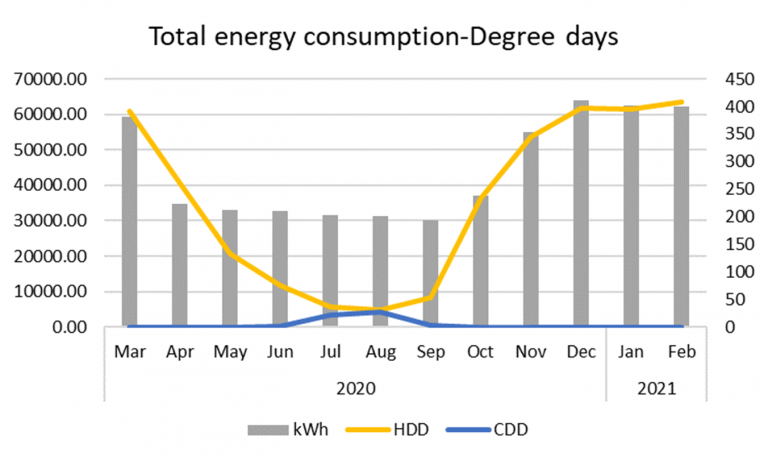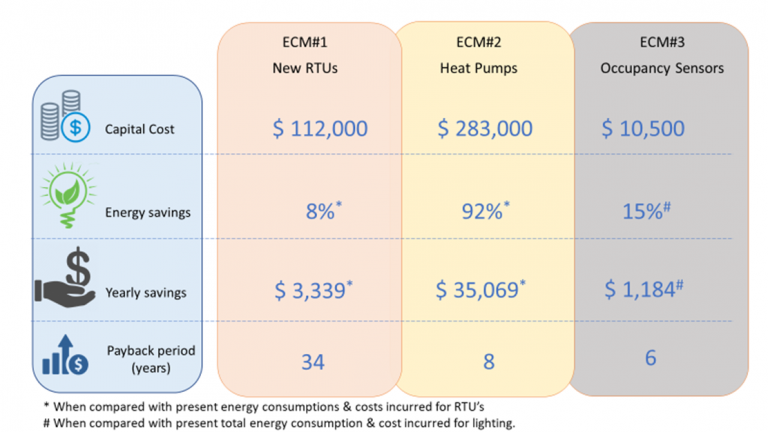Suman Mandal | MEL Candidate | Dec 17, 2021.
Mentors: Emma Bowman and David Garcia, Modern Niagara;
Abstract
This project aims on studying the energy-consumption profile of a four-story commercial building in downtown Vancouver and evaluates three energy-saving alternatives to identify the best sustainable and economically viable option(s).
The facility’s last year utility bills were analyzed to check the proportionate use of each different energy source and to estimate the total amount spent on energy. These parameters were then used for benchmarking with similar buildings to determine the scope for improvements. Next, an energy audit was performed to understand the current energy usage pattern and to identify alternatives to reduce the energy costs of the existing systems. These observations were then compared with the results of three viable energy-saving alternatives from the point of view of energy, cost savings and payback periods.
It was found that replacing the existing RTUs with high-efficiency heat pumps would result in a saving of 92% more energy compared to the present system. Whereas, replacing the same with new higher efficiency RTUs would yield 8% yearly savings only. Additionally, installing occupancy sensors would lead to an overall 15% reduction in electricity consumption for lighting.
Introduction
Buildings, ranging from residential high rises to commercials, are responsible for about 30% of the world’s energy use and 28% of global greenhouse gas emissions#. This extensive use of energy in the building sector creates opportunities for implementing several energy conservation measures. It is estimated that the energy consumption in new and old buildings could be reduced by 30% to 80% through the efficient use of existing technologies. One of the most important direct benefits that can be obtained from the retrofitting of a building is a reduction in energy costs and operating costs of electro-mechanical equipment. A detailed cost-benefit analysis can be obtained with the help of economic indicators such as Simple payback period, Net present value (NPV), Internal rate of return (IRR) etc. to establish the economic feasibility of the retrofitting project.
Methodology
In this study, the energy system of the building was analyzed in four different steps.
Step 1: Analyzing utility data of the building and Benchmarking
In this step, utility bills of the facility were collected to identify energy use patterns and the effect of weather conditions on energy use at the building. Next, benchmarking indices were calculated to compare with typical benchmarking data of similar kinds of buildings to find out the scope for improvements.
Step 2: Performing an energy audit of the facility
An energy audit was performed to identify energy conservation measures and to understand the existing operating conditions, operating hours and present O&M practices of major energy-consuming equipment.
Step 3: Creating a baseline for building energy use
In this step, a baseline was created based on the energy use data of the building to estimate the energy savings opportunities from the proposed energy conservation measures.
Step 4: Evaluation of energy conservation measures A list of energy conservation measures was determined and analyzed to establish the feasibility of economic and energy-saving opportunities.


Results and Discussion
Based on the assessment of energy use patterns, cost incurred for the energy use and present operating practices of the facility, several Energy Conservation Measures (ECMs) for the building were analyzed. Among the ECMs considered in the study, three successfully reduced energy consumption. The results of the three ECMs were evaluated with a final goal of transforming the building’s energy consumption to become more economic and energy-efficient. It was found that ECM#1, which involved changing present RTUs with a new, and efficient equal number of RTUs would provide an energy savings of 8% within a payback period of 34 years. ECM#2, which suggested changing the present RTUs with high-efficiency Heat pumps, would give an energy savings of 92% within a payback period of 8 years. In ECM#3, equipping the building with occupancy censors would offer an energy savings of 15% within a payback period of 6 years.

In this study, a set of measures was analyzed to improve energy efficiency by lowering energy consumptions and energy costs. The main focus of the study was to find out the economic feasibility of energy-saving opportunities. Overall, three alternatives were evaluated. The results have shown that major energy saving could be attained when the present RTUs are replaced by Heat pumps which are more efficient and are driven by electricity. This change would not only cut down the total energy consumption of the facility because of its higher efficiency but also will reduce GHG emissions. On top of it, the government incentives, if availed would lower the total cost of the installation. Also, the simple payback period for ECM#2 was found to be much less than that of ECM#1 because it showed a much higher potential to save energy. Additionally, results show that ECM#3 can also be considered as a low-cost energy-saving measure with a moderate payback period.

Conclusion
It could be concluded that although ECM#2 would entail a large capital cost, the facility would be benefited in the long run by saving energy costs. The payback period is also less because of the large savings coupled with government incentives. Additionally, ECM#2 would cut down the GHG emission significantly by reducing total natural gas usage in the facility. Finally, ECM#3 would further reduce the electricity consumption by another 15% and has a reasonable payback period of 6 years. Thus, it is recommended to opt for ECM #2 and #3 to get visible savings in the energy cost of the building.
References
- Krarti, M.(2000). “Energy Audit of Building Systems – An Engineering Approach”. New York, CRC Press
- Capehart, B.L., Turner, W.C., Kennedy, W.J., (2011),” Guide to Energy Management”, Georgia, Fairmont PressContact
- Buildings – A source of enormous untapped efficiency potential, retrieved from: https://www.iea.org/topics/buildings
- Building Owners and Managers Association: https://bomacanada.ca/
- Weather Dashboard for Vancouver: https://vancouver.weatherstats.ca/
- COMMERCIAL BUILDINGS ENERGY CONSUMPTION SURVEY (CBECS): https://www.eia.gov/consumption/commercial/data/2012/index.php?view=consumption#c1-c12
- 2020 B.C Best practices methodology for quantifying greenhouse gas emissions: https://www2.gov.bc.ca/assets/gov/environment/climate-change/cng/methodology/2020-pso-methodology.pdf
- New plan makes it easier to switch from fossil fuels to made-in-B.C. clean electricity: https://news.gov.bc.ca/releases/2021PREM0059-001861
Contact Details
Suman Mandal, PMP, CEM
Email: suman07@student.ubc.ca
Phone: 778-316-6752
www.linkedin.com/in/suman-ubc